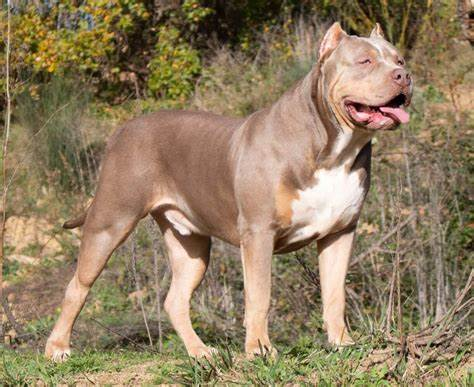The XL Bully, a prominent variant of the American Bully breed, has garnered significant attention due to its distinctive appearance and temperament. This comprehensive guide delves into the origins, physical characteristics, temperament, care requirements, and considerations for potential owners of the XL Bully.
Origins and History
The American Bully breed, including the XL variant, emerged in the 1980s and 1990s through the crossbreeding of American Pit Bull Terriers, American Staffordshire Terriers, and various Bulldog breeds. The goal was to create a dog that combined the loyalty and strength of pit bulls with the calm temperament and muscular build of bulldogs. Over time, selective breeding shaped the distinctive look of today’s American Bullies, which are recognized in several sizes, including XL.
Physical Characteristics
The XL Bully is characterized by its impressive size and muscular build. Males typically stand between 20 to 23 inches tall, while females range from 19 to 22 inches. Their weight varies between 60 to 130 pounds, with males generally being heavier. The breed features a broad skull, short muzzle, round eyes, cropped or natural ears, broad chest, thick neck, and a short, wide tail. Their coat is short and glossy, with colors including black, white, gray, brown, blue, and tan.
Temperament
XL Bullies are recognized for being lovable and amiable despite their strong build.They are typically good with children and can be friendly with strangers, other dogs, and other animals. Aggression, whether human or canine, extreme shyness, or viciousness are highly undesired and quite unusual of the American Bully.
Care and Maintenance
XL Bullies are highly active and energetic dogs that require regular exercise to maintain their muscular physique. Daily walks, playtime, and mental stimulation are essential to keep them healthy and happy. Their short coat is low-maintenance, requiring regular brushing to remove loose hair and occasional baths to keep their skin healthy. Regular veterinary check-ups are important to monitor their health and address any potential issues.
Training and Socialization
Early socialization and consistent, positive reinforcement training are crucial for XL Bullies. They are intelligent and eager to please, making them responsive to training. Socializing them with various people, environments, and other animals from a young age helps prevent behavioral issues and ensures they grow into well-rounded adults.
Health Considerations
Like all breeds, XL Bullies are susceptible to certain health conditions, including hip dysplasia, heart disease, and skin allergies. Maintaining a healthy diet, regular exercise, and routine veterinary care can help mitigate these risks. It’s important to be aware of the breed’s specific health concerns and work closely with a veterinarian to ensure their well-being.
Legal Considerations
In some regions, XL Bullies are subject to breed-specific legislation. For instance, in Ireland, XL Bullies are classified as restricted due to their strength and potential danger. Owners of restricted breeds must adhere to strict rules, including muzzling their dogs in public, using strong chains for leads, and ensuring the dogs wear collars with the owner’s information. Violations of these rules can result in fines or seizure of the dog.
FAQs
What is an XL Bully?
An XL Bully is a larger variant of the American Bully breed, known for its muscular build, broad chest, and strong appearance. Developed by crossbreeding breeds like the American Pit Bull Terrier, American Staffordshire Terrier, and various bulldog breeds, the XL Bully combines strength with a gentle temperament.
How big do XL Bullies get?
Male XL Bullies typically stand between 20 to 23 inches (51 to 58 cm) tall at the shoulder, while females range from 19 to 22 inches (48 to 56 cm). Their weight varies between 70 to 130 pounds (32 to 59 kg), depending on factors like genetics and diet.
What is the temperament of an XL Bully?
Despite their formidable appearance, XL Bullies are known for their affectionate and loyal nature. They are generally good with children and can get along well with other pets when properly socialized. Their temperament is gentle and friendly, making them excellent family companions.
Are XL Bullies good with children?
Yes, XL Bullies are typically good with children. Their gentle and affectionate nature makes them suitable family pets. However, as with any breed, it’s essential to supervise interactions between dogs and young children to ensure safety for both.
How much exercise does an XL Bully need?
XL Bullies are energetic dogs that require regular exercise to maintain their health and happiness. Daily walks, playtime, and mental stimulation are essential to keep them fit and prevent boredom-related behaviors.
What is the lifespan of an XL Bully?
The average lifespan of an XL Bully is between 10 to 12 years. Providing proper care, a balanced diet, regular exercise, and routine veterinary check-ups can contribute to a longer, healthier life.
What are the grooming requirements for an XL Bully?
XL Bullies have short, smooth coats that are relatively low-maintenance. Regular brushing helps remove loose hair and keeps their coat shiny. Bathing should be done as needed, and routine care like nail trimming, ear cleaning, and dental hygiene is important.
Are XL Bullies aggressive?
No, XL Bullies are not inherently aggressive. They are known for their friendly and gentle demeanor. Proper training and socialization from a young age are crucial to ensure they develop into well-behaved adults.
What is the difference between an XL and XXL American Bully?
The primary difference lies in size. While XL Bullies have the dimensions mentioned earlier, XXL Bullies are larger, though specific measurements can vary. Both share similar temperaments and physical characteristics.
How much does an XL Bully puppy cost?
The price of an XL Bully puppy can vary widely based on factors like breeder reputation, bloodline, and location. On average, prices range from $2,500 to $5,000, but exceptional pedigrees can command higher prices.
What are common health issues in XL Bullies?
XL Bullies can be prone to certain health conditions, including hip dysplasia, heart disease, and skin allergies. Regular veterinary care and a healthy lifestyle can help manage and prevent some of these issues.
To read more,Click Here.





